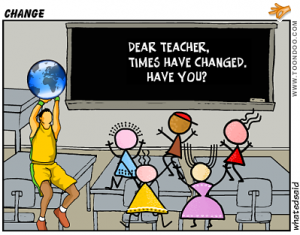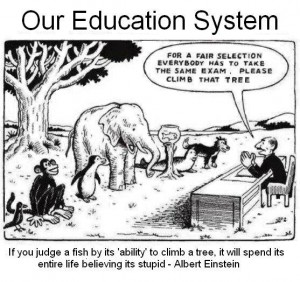Photo courtesy of http://www.chan6es.com/psychology/category/teaching%20changes
With the introduction of new technology, new curriculum, and new school wide focus (i.e. self-regulation, inquiry-based learning, etc.), changes in teachers’ practices and student’s learning are inevitable. Some people are enthusiastic and welcoming to innovation, while others are anxious and reluctant to change. I had witnessed the process of change at my school for the last four years, and observed different level of concerns, acceptance in individuals. As I studied the concern-based adoption model, I could make connection to my observation and experience during the change at my school.
Screenshots of the Concern-Based Adoption Model website (http://www.nationalacademies.org/rise/backg4a.htm)
Four years ago, my current administrator came to my school and introduced a school-wide focus to the teaching staffs: differentiated instruction and inquiry-based learning. At that time, the teaching staffs consisted of 10 classroom teachers, two leaner support teachers (LST), the teacher-librarian (TL) and myself (core music teacher). Over half of the classroom teachers were veteran teachers approaching retirement, while others, comparatively, were “young” teachers with less than 15 years of experience. When the school-wide focus was first introduced at a staff meeting, it was apparent that the “young” teachers were at the informational stage of concerns and were at the orientation level of use. They requested for workshops, discussion forums, and teaching materials/ideas to experiment differentiated instruction in their classrooms. However, on the other hand, 3 out of the 5 veteran teachers were resistant to the innovation, while the other two veteran teachers showed concerns but willing to explore the new concepts. The three who resisted were at the personal stage of concerns in a negative way, questioning how their current practices different from the new idea. They were also at the non-use level of use, showing no interest or willingness to experiment the new method of instruction. As a result, there were conflicts among staffs and administrators and the veteran teachers either chose to have an early retirement or transfer to another school.
Today, four years after the school-wide focus was first introduced, the teaching staffs consist of 9 classroom teachers, two LST, a TL and myself. The two veteran teachers are still at my school, and over the past four years, they had moved along the scale and had reached the collaboration stage of concerns and renewal level of use. The other 7 classroom teachers are at different stage of concerns and level of use according to CBAM. I had interviewed two teachers regarding their pedagogies, their use of library service, and their suggestions on collaboration with the TL.
Teacher #1: Ms. I, Kindergarten/Grade 1 Teacher
Ms. I is an adventurous teacher who always volunteers to attend district workshops on new pedagogy, teaching resources or educational applications on iPads. Afterwards, she would share her learning with staffs at staff meetings. In the staffroom during lunchtime, Ms. I sometimes shares her challenges in teaching and collects suggestions/ideas from other colleagues. She definitely is at the refocusing and collaboration stages of concerns. In the past two years, she has been gradually introducing research and note taking skills to her kindergarten and grade one students through class read-aloud and discussion. In addition, she works with small group of students during literacy centers time to reinforce the skills. She has beginner readers, as well as fluent, above grade level readers in her class. Ms. I works collaboratively with the LST teacher in the planning of the literacy centers that could accommodate readers of different levels. Students have been working on inquiry project on animals in one of the literacy centers. Ms. I prepares a basket of animal books in different reading levels, and guides students individually on note-taking skills. She constantly asks the administrator, who specializes in early literacy development, for advice and new ideas/materials in developing literacy in her class. Ms. I demonstrates that she is at the top level of use: renewal.
Use of the School Library Service
Ms. I class has a 40-minutes library class once a week. Ms. I will have 40-minutes of preparation time while the class is in the library with the TL. Ms. I shared with me in our interview that the only reference service that the TL provided her was to pull out books from the shelves for the class social studies/science inquiry projects. Ms. I expressed that the reference books in the library are too difficult for her students to read independently, and it is a challenge to collaborate with the TL when the TL works only 1.5 days per week at our school. It is discouraging to know that there is no effort from either party (Ms. I and the TL) to approach each other and initiate opportunities for collaboration.
Suggestion for Collaboration
When I asked Ms. S to give suggestions on how the TL could collaborate with her in teaching practice, she shared her experience of learning note-taking skills from the teacher-librarian when she was in grade five. Ms. S suggested that the TL could teach the class research and note-taking skills instead of doing story read-aloud during library classes.
Teacher #2: Ms. S, Grade 3 – 5 Discovery Program Teacher
My school is a neighbourhood school with two streams: the regular neighbourhood program and the discovery program. A discovery class is a multi-aged class with a focus on self-regulated and inquiry-based learning. When Ms. S came to the school four years ago as a long-term substitute teacher, she was a newly graduate of the Bachelor of Education. She shared with me in our interview that her focus was on inquiry-based learning during her teacher training and practicum. Therefore, she was already at the top of the ladder according to the CBAM: Refocusing [stage of concerns] and renewal [level of use].
Ms. S believes that students should learn in their own pace and she should teach according to the student’s ability and mentality.
Photo courtesy of http://learnenglish-2016.blogspot.ca/2014/11/today-there-is-some-changes-in.html
At the beginning of the school year, Ms. S taught the class several activities for inquiry learning that they will be doing for thematic studies. As it is a multi-aged class, Ms. S prepares resources in different formats and reading level in order to accommodate the diversity of the class. As students work independently on the inquiry activities, Ms. S could work with individual student who needs assistance.
Use of Library Service
Same as Ms. I’s class, Ms. S’s class visits the library once a week for book exchange and story read-aloud. The only library reference service that Ms. S would receive from our school library is the TL gathering reference books for the class’ thematic studies. However, as Ms. S feels that our school library’s references are mostly outdated, she would borrow reference books from the public library for the students to use in class. Ms. S had encouraged students to use online reference resources listed in our school library online catalog, but students do not have the mentality and skills to evaluate if the online resources is appropriate. In order to avoid the frustration while students searching for appropriate online resources, Ms. S recommends several online resources that she personally discovered and evaluated for appropriateness. It is disappointing that there is no collaboration between Ms. S and the TL because of the limited time the TL is available at the school.
Suggestion for Collaboration
According to Ms. S, the TL never approach her to initiate collaboration opportunities; nor Ms. S would seek assistance from the TL. As Ms. S feels that after working with the same class of students for two years, her inquiry-based learning program and routine are fully developed, collaboration with the TL is not necessary.
Sincerely, I have asked Ms. S to provide me with suggestion on how the TL could provide better service to her and her class. Coincidently, same as Ms. I, Ms. S suggested the TL to demonstrate and reinforce research and note-taking skills during library classes, instead of story read-aloud.
Conclusion
I was impressed by the exceptional work of Ms. I and Ms. S with their students on inquiry-based learning. However, it is disappointing to discover that the TL could not work collaboratively with the teachers due to her constrain in time. Is it impossible for the TL to work collaboratively with the teachers? I believe not, but the TL has to take the initiative and before/after school time to make it happen. As I had mentioned in my previous blog post for theme one, we, as TL, should not wait for the teachers to come to us, but to reach out and take initiative in suggesting collaboration. The following video that I discovered on YouTube could be used to advocate library service and encourage collaboration.
References:
Concerns-Based Adoption Model. Web. 29 Feb. 2016. <https://sites.google.com/site/ch7cbam/home>.
“The Concerns-Based Adoption Model (CBAM): A Model for Change in Individuals.” The National Academies. 2005. Web. 29 Feb. 2016. <http://www.nationalacademies.org/rise/backg4a.htm>.





Thanks for sharing this great video! I will share it with my staff. I am glad to read that both teachers are on board with having the TL do different tasks other than story read aloud which is such an isolating activity. Helping student evolve research skills will connect with their classroom experience that will deepen the relationship with the teacher and TL.